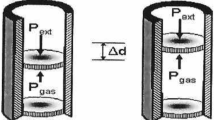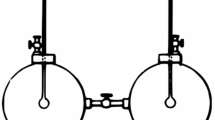Abstract
We study thermodynamic operations which bring a nonequilibrium steady state (NESS) to another NESS in physical systems under nonequilibrium conditions. We model the system by a suitable Markov jump process, and treat thermodynamic operations as protocols according to which the external agent varies parameters of the Markov process. Then we prove, among other relations, a NESS version of the Jarzynski equality and the extended Clausius relation. The latter can be a starting point of thermodynamics for NESS. We also find that the corresponding nonequilibrium entropy has a microscopic representation in terms of symmetrized Shannon entropy in systems where the microscopic description of states involves “momenta”. All the results in the present paper are mathematically rigorous.








Similar content being viewed by others
Notes
This part can be read as a summary of the whole paper.
To be precise, this is true when there always is a nonvanishing temperature difference. When \(\beta _1(t)=\beta _2(t)\), the currents are very small and we rather have \(J^\dagger _k(t)\simeq -J_k(-t)\).
The standard generator of a stochastic process is given by the transpose of \(\mathsf {R}\).
Throughout the present paper, the entropy production always means the entropy production in the heat baths.
The approach to equilibrium is indeed a nonequilibrium phenomenon that can be studied in the framework of equilibrium dynamics.
We assume here (and in what follows) that each transition is associated with only a single bath. See also Sect. 2.4.
Such measurements are indeed possible in modern calorimetry.
One strategy is to measure the back action from the system to the generator (such as a coil) of the field. In a colloidal system it may be possible to determine the work done by the field by precisely measuring the positions of charged particles.
In most of realistic situations for heat conduction, only some small portions of the system is in touch with the heat baths. To model such a situation by using a system of particles on a lattice, we assume that the energy of the system changes only when a particle hops within one of the portions which are in touch with the baths. In other words, if an allowed transition \({x\rightarrow y}\) is such that a particle hops outside the portions, then one must have \(H^\nu _x=H^\nu _y\). We further use the transition rule (2.28) so as to make the corresponding transition rate (which is indeed 1) independent of any inverse temperatures.
We define the force in this setting as \(f_{{x\rightarrow y}}=f d_{x\rightarrow y}\). The force \(f_{x\rightarrow y}\) is said to be conservative if one can write \(f_{{x\rightarrow y}}=U_x-U_y\) for any \(x,y\in \mathcal{S}\) with a suitable function (i.e., potential) \(U_x\).
A convenient derivation is to start from (3.5) with \(\kappa =1\), and apply the cumulant expansion as above.
In a system with parameters (2.34) with a nonequilibrium protocol \((\beta ,\nu (t),f(t))\), for example, we choose the equilibrium protocol as \((\beta ,\nu (t),0)\).
For simplicity we only consider protocols in which the reference inverse temperature \(\beta \) is fixed. It is not difficult to treat protocols where \(\beta \) varies; one simply redefines \(\beta \) properly when one decomposes the whole protocol into a sum of step protocols.
To be consistent with the notation introduced in Sect. 2.1, we are here taking \(\tau _0=\{(N-1)/(N+1)\}\tau \). In this case \(\tau _0\) also diverges when we let \(\tau \uparrow \infty \).
The difference between \(\bigl \langle \Psi ^{(\alpha )}\bigr \rangle ^{\tau ,(\alpha _\mathrm {eq})}_{x\rightarrow }\) and \(\bigl \langle \Psi ^{(\alpha )}\bigr \rangle ^{\tau ,(\alpha )}_{x\rightarrow }\) is proportional to \(\epsilon ^2\), but is also roughly proportional to \(\tau \). Thus the difference diverges as \(\tau \uparrow \infty \).
It may be also reasonable to consider a model in which \(\lambda ^\alpha _x\ne \lambda ^\alpha _{x^*}\). In such a model, one should include the contribution from \(\lambda ^\alpha _x/\lambda ^\alpha _{x^*}\) into the definition of \(\Theta ^{{\hat{\alpha }}}[\hat{x}]\) so as to keep the symmetry (10.3) valid (see [45]). Then all the results in the present section remain valid.
One can also compute the expectation value of the entropy production rate explicitly as \(\sum _x\sigma _x^{(\beta _1',\beta _2')}\,p_x(t) =\sigma _\mathrm {st}^{(\beta _1',\beta _2')} +[\beta _1'\{u(\beta _1)-u(\beta _1')\} +\beta _2'\{u(\beta _2)-u(\beta _2')\}] (2L)^{-1}\sum _{j=1}^L\lambda ^jt^{j-1}e^{-\lambda t}\) for \(t\ge 0\). It decays exponentially to the steady value.
The term \(O(\epsilon ^2\delta )\) is nonvanishing.
References
Oono, Y., Paniconi, M.: Steady state thermodynamics. Prog. Theor. Phys. Suppl. 130, 29–44 (1998)
Komatsu, S.T., Nakagawa, N., Sasa, S.-I., Tasaki, H.: Steady state thermodynamics for heat conduction—microscopic derivation, Phys. Rev. Lett. 100, 230602 (2008). arXiv:0711.0246
Komatsu, T.S., Nakagawa, N., Sasa S.-I., Tasaki, H.: Entropy and nonlinear nonequilibrium thermodynamic relation for heat conducting steady states. J. Stat. Phys. 142, 127–153 (2011). arXiv:1009.0970
Landauer, R.: \(dQ= TdS\) far from equilibrium. Phys. Rev. A 18, 255–266 (1978)
Ruelle, D.: Extending the definition of entropy to nonequilibrium steady states. Proc. Natl. Acad. Sci. USA. 100, 3054–3058 (2003). arXiv:cond-mat/0303156
Saito, K., Tasaki, H.: Extended Clausius relation and entropy for nonequilibrium steady states in feat conducting quantum systems. J. Stat. Phys. 145, 1275–1290 (2011). arXiv:1105.2168
Sagawa, T., Hayakawa, H.: Geometrical expression of excess entropy production. Phys. Rev. E 84, 051110 (2011). arXiv:1109.0796
Yuge, T., Sagawa, T., Sugita, A., Hayakawa, H.: Geometrical excess entropy production in nonequilibrium quantum systems. J. Stat. Phys. 153, 412–441 (2013). arXiv:1305.5026
Hatano, T., Sasa, S.-I.: Steady-state thermodynamics of Langevin systems. Phys. Rev. Lett. 86, 3463 (2001). arXiv:cond-mat/0010405
Bertini, L., Gabrielli, D., Jona-Lasinio, G., Landim, C.: Thermodynamic transformations of nonequilibrium states. J. Stat. Phys. 149, 773–802 (2012). arXiv:1206.2412
Bertini, L., Gabrielli, D., Jona-Lasinio, G., Landim, C.: Clausius inequality and optimality of quasistatic transformations for nonequilibrium stationary states. Phys. Rev. Lett. 110, 020601 (2013). arXiv:1208.1872
Jona-Lasinio, G.: Thermodynamics of stationary states. J. Stat. Mech. 2014, P02004 (2014)
Maes, C., Netocny, K.: A nonequilibrium extension of the Clausius heat theorem. J. Stat. Phys. 154, 188–203 (2014). arXiv:1206.3423
Sasa, S.-I.: Possible extended forms of thermodynamic entropy. J. Stat. Mech. P01004 (2014). arXiv:1309.7131
Sasa, S.-I., Tasaki, H.: Steady state thermodynamics. J. Stat. Phys. 125, 125–224 (2006). arXiv:cond-mat/0411052
Pradhan, P., Amann, C.P., Seifert, U.: Nonequilibrium steady states in contact: approximate thermodynamic structure and zeroth law for driven lattice gases. Phys. Rev. Lett. 105, 150601 (2010). arXiv:1002.4349
Pradhan, P., Amann, C.P., Seifert, U.: Approximate thermodynamic structure for driven lattice gases in contact. Phys. Rev. E 84, 041104 (2011). arXiv:1107.5434
Dickman, R., Motai, R.: Inconsistencies in steady state thermodynamics (2014). (in press) arXiv:1401.1678
Boksenbojm, E., Maes, C., Netocny, K., Pesek, J.: Heat capacity in nonequilibrium steady states. Euro Phys. Lett. 96, 40001 (2011). arXiv:1109.3054
Mandal, D.: Nonequilibrium heat capacity. Phys. Rev. E 88, 062135 (2013). arXiv:1311.7176
Nakagawa, N.: Universal exact expression for adiabatic pumping in terms of non-equilibrium steady states (2014) (in press). arXiv:1401.4242
Bertini, L., De Sole, A., Gabrielli, D., Jona-Lasinio, G., Landim, C.: Fluctuations in stationary nonequilibrium states of irreversible processes. Phys. Rev. Lett. 87, 040601 (2001). arXiv:cond-mat/0104153
Bertini, L., De Sole, A., Gabrielli, D., Jona-Lasinio, G., Landim, C.: Large deviation approach to non equilibrium processes in stochastic lattice gases. Bull. Braz. Math. Soc. 37, 611–643 (2006). arXiv:math/0602557
Bertini, L., De Sole, A., Gabrielli, D., Jona-Lasinio, G., Landim, C.: Towards a nonequilibrium thermodynamics: a self-contained macroscopic description of driven diffusive systems. J. Stat. Phys. 135, 857–872 (2009). arXiv:0807.4457
Jona-Lasinio, G.: From fluctuations in hydrodynamics to nonequilibrium thermodynamics. Prog. Theor. Phys. Suppl. 184, 262 (2010). arXiv:1003.4164
Derrida, B., Lebowitz, J.L., Speer, E.R.: Free energy functional for nonequilibrium systems: an exactly solvable case. Phys. Rev. Lett. 87, 150601 (2001). arXiv:cond-mat/0105110
Derrida, B., Lebowitz, J.L., Speer, E.R.: Exact large deviation functional of a stationary open driven diffusive system: the asymmetric exclusion process. J. Stat. Phys. 110, 775–810 (2003). arXiv:cond-mat/0205353
Bodineau, T., Derrida, B.: Current fluctuations in nonequilibrium diffusive systems: an additivity principle. Phys. Rev. Lett. 92, 180601 (2004). arXiv:cond-mat/0402305
Lieb, E.H., Yngvason, J.: The entropy concept for non-equilibrium states. Proc. R. Soc. A 469, 20130408 (2013). http://rspa.royalsocietypublishing.org/content/469/2158/20130408
Seifert, U.: Stochastic thermodynamics, fluctuation theorems, and molecular machines. Rep. Prog. Phys. 75, 126001 (2012). arXiv:1205.4176
Spinny, R.E., Ford, I.J.: Non-equilibrium thermodynamic systems with odd and even variables. Phys. Rev. Lett. 108, 170603 (2012). arXiv:1201.0904
Jarzynski, C.: Nonequilibrium equality for free energy differences. Phys. Rev. Lett. 78, 2690 (1997). arXiv:cond-mat/9610209
Crooks, G.E.: Entropy production fluctuation theorem and the nonequilibrium work relation for free energy differences. Phys. Rev. E 60, 2721 (1999). arXiv:cond-mat/9901352
Crooks, G.E.: Path-ensemble averages in systems driven far from equilibrium. Phys. Rev. E 61, 2361, (2000). arXiv:cond-mat/9908420
Seifert, U.: Entropy production along a stochastic trajectory and an integral fluctuation theorem. Phys. Rev. Lett. 95, 040602 (2005). arXiv:cond-mat/0503686
Maes, C., Netocny, K.: Time-reversal and entropy. J. Stat. Phys. 110, 269–310 (2003). arXiv:cond-mat/0202501
Baiesi, M., Maes, C., Wynants, B.: Fluctuations and response of nonequilibrium states. Phys. Rev. Lett. 103, 010602 (2009). arXiv:0902.3955
Baerts, P., Basu, U., Maes, C., Safaverdi, S.: The frenetic origin of negative differential response. Phys. Rev. E 88, 052109 (2013). arXiv:1308.5613
Nakagawa, N.: Work relation and the second law of thermodynamics in nonequilibrium steady states. Phys. Rev. E 85, 051115 (2012). arXiv:1109.1374
Komatsu, T.S., Nakagawa, N.: An expression for stationary distribution in nonequilibrium steady state. Phys. Rev. Lett. 100, 030601 (2008). arXiv:0708.3158
Maes, C., Netocny, K.: Rigorous meaning of McLennan ensembles. J. Math. Phys. 51, 015219 (2010). arXiv:0911.1032
Dembo, A., Zeitouni, O.: Large Deviations Techniques and Applications. Springer, New York (1998)
Komatsu, T.S., Nakagawa, N., Sasa S.-I., Tasaki, H.: Representation of nonequilibrium steady states in large mechanical systems. J. Stat. Phys. 134, 401–423 (2009). arXiv:0805.3023
Cover, T.M., Thomas, J.A.: Elements of Information Theory. Wiley-Interscience, New York (2006)
Itami, M., Sasa, S.-I.: Nonequilibrium statistical mechanics for adiabatic piston problem. J. Stat. Phys. 158, 37–56 (2015)
Acknowledgments
It is a pleasure to thank Hisao Hayakawa, Masato Itami, Nobuyasu Ito, Chris Jarzynski, Gianni Jona-Lasinio, Joel Lebowitz, Christian Maes, Karel Netocny, Yoshi Oono, Glenn Paquette, Takahiro Sagawa, Keiji Saito, Herebert Spohn, and Akira Shimizu for valuable discussions. The present study was supported by KAKENHI Nos. 22340109, 23540435, and 25103002, by the JSPS Core-to-Core program “Non-equilibrium dynamics of soft-matter and information”, and partially by JSPS and Leading Research Organizations, namely NSERC, ANR, DFG, RFBR, RCUK and NSF as Partner Organizations under the G8 Research Councils Initiative for Multilateral Research Funding.
Author information
Authors and Affiliations
Corresponding author
Rights and permissions
About this article
Cite this article
Komatsu, T.S., Nakagawa, N., Sasa, Si. et al. Exact Equalities and Thermodynamic Relations for Nonequilibrium Steady States. J Stat Phys 159, 1237–1285 (2015). https://doi.org/10.1007/s10955-015-1221-1
Received:
Accepted:
Published:
Issue Date:
DOI: https://doi.org/10.1007/s10955-015-1221-1




